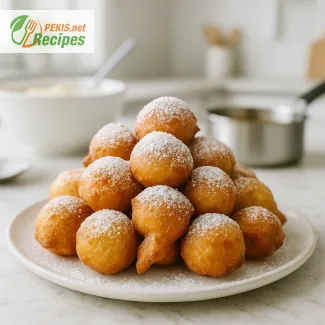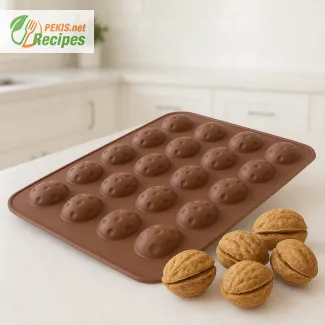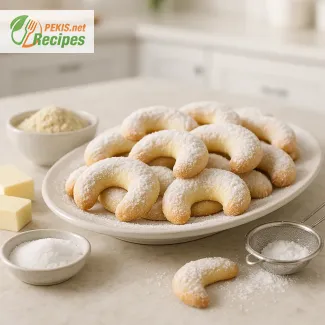A bite into Slovenian fried dough mice delivers a rush of warmth, the crisp golden shell cracking open to a soft, airy centre scented with vanilla and lemon zest. Born from cosy Carnival traditions, these small spoon-dropped fritters transform simple pantry ingredients into irresistible, fluffy treats that feel nostalgic, comforting and joyfully indulgent.
Small adjustments in dough temperature and mixing time make the biggest difference here—letting the batter rest just a moment helps those fluffy, cloud-light centres develop without becoming oily. Sharing techniques behind these nostalgic fritters comes naturally after years of refining textures and balancing simple ingredients into something memorable.
PEKIS – professional chef and recipe developer with over 25 years of experience in cooking and baking, specialized in European and international cuisine.

Golden Slovenian carnival bites that stay soft and fluffy inside
Irresistible fried dough “mice” with a crisp shell and cloud-light centre
The first bite into freshly fried Slovenian mice is always a tiny shock of happiness: the crisp, whisper-thin crust gives way with a soft crackle, and underneath jealously hides a pillowy, airy centre that is still warm and fragrant. A gentle hint of citrus zest, a touch of vanilla and the sweetness of powdered sugar dusting your fingers turn these small fried dough bites into something far more emotional than “just” dessert. For many, they taste like Carnival afternoons, like noisy kitchens, like impatiently waiting next to the stove for the next batch to rise and float in the shimmering oil.
What makes Slovenian fried dough “mice” special
Slovenian fried dough bites, often called “miške”, are cousins of doughnuts and fritters, but they have their own personality. The dough is usually looser and lighter, so it falls from the spoon into the hot oil in soft clouds rather than in perfectly shaped rings. This gives each mouse its unique, rustic shape and creates that signature combination of crispy nubs outside and a moist, fluffy interior. A balanced mix of eggs, milk, flour, sugar and fat builds structure, while leavening (yeast or baking powder, depending on the style) lifts the batter into delicate, irregular puffs.
Unlike heavy fried sweets that can feel greasy, well-made mice are surprisingly light. Controlled oil temperature keeps them from soaking up too much fat, so the result is a golden, non-oily crust that carries flavour instead of overwhelming it. A final shower of powdered sugar or a subtle cinnamon-sugar mix adds aroma and just enough sweetness.
Short origin story: from Carnival kitchens to cosy weekends
In many Slovenian homes, mice belong to Carnival and winter weekends. They appear when the weather is cold, the house smells of yeast, vanilla and hot oil, and the table is crowded with mugs of tea or cocoa. Similar fried treats exist across Central Europe, but Slovenian versions tend to be smaller, softer and less sweet, designed to disappear in two or three bites. Over time, the recipe has travelled from grandmothers’ notebooks to modern kitchens with stand mixers and digital thermometers, but the soul of the dessert remains the same: simple pantry ingredients, carefully handled, transformed into something festive.
Ingredient spotlight: how each component shapes texture and flavour
Flour, leavening and liquid
- Flour creates the backbone of the dough, giving the mice enough structure to puff rather than collapse. Choosing a medium-protein wheat flour keeps them tender, not chewy.
- Leavening (yeast or baking powder) is responsible for the airy, honeycomb interior. The right amount ensures that each bite feels light, not dense, and that the mice stay soft even after cooling.
- Milk or buttermilk adds moisture, gentle tang and richness, helping the crumb stay soft and slightly custardy instead of dry.
Eggs, fat and sugar
- Eggs contribute colour, flavour and elasticity, helping the dough set into a silky, moist crumb and giving each bite a subtle egg-custard note.
- Butter or neutral oil in the dough adds softness and depth, preventing the interior from drying out and supporting that melt-in-the-mouth feeling.
- Sugar is kept moderate so that the mice don’t become cloying; it assists with browning and enhances the natural flavours of vanilla and citrus.
Aromatics and finishing touches
- Lemon or orange zest lifts the fried dough with fresh, sunny notes, making the dessert feel lighter and more elegant.
- Vanilla (paste, extract or seeds) rounds out the flavour with a warm, bakery-like aroma.
- A final coat of powdered sugar gives a soft, snowy finish that clings to the crispy edges.
If you enjoy dough that stays soft and oil-free, you might also like the related recipe for Soft homemade donuts without oily taste – foolproof recipe guide, which explores similar techniques for keeping fried treats light. And if you prefer something from the pan rather than deep-fried, the recipe for Thin European-Style Rice Pancakes – Light and Crispy Delight shows how to achieve that same delicate, lacy texture in a different format.
Semantic focus: Slovenian Carnival dessert, fried dough bites and coffee treats
These Slovenian fried dough bites fit naturally into the world of Carnival desserts, coffee-time pastries and weekend treats. They are small enough to serve as a sweet snack with coffee, generous enough to stand in for dessert after a simple meal, and festive enough to appear on a holiday platter alongside doughnuts, strudels and potica. For many readers searching for traditional Slovenian sweets, mice offer a less intimidating alternative to filled doughnuts, with all of the flavour and much less shaping work.
Why you’ll love this recipe
- Fluffy interior: each bite feels soft, light and airy, not heavy.
- Crisp, golden crust: the surface stays delicately crunchy without greasy residue.
- Simple ingredients: everything comes from a standard pantry and fridge.
- Beginner-friendly method: no complicated shaping, just spoonfuls dropped into oil.
- Perfect for sharing: the small size makes them ideal for platters, parties and family weekends.
Creative variations to keep your mice exciting
- Citrus twist: increase orange or lemon zest and add a few drops of orange blossom water for a brighter, more aromatic version.
- Spiced winter mice: fold in ground cinnamon, nutmeg or cardamom to turn them into a cosy winter spice dessert.
- Chocolate drizzle: once cooled, drizzle with dark chocolate ganache or dip one side of each mouse for a semi-coated effect.
- Filled surprise: pipe a small amount of jam, hazelnut spread or vanilla cream into larger mice for a cross between fritters and mini doughnuts.
- Crisp sugar coat: roll the still-warm mice in fine granulated sugar mixed with cinnamon for extra crunch.
Storage and make-ahead tips
Mice are at their absolute best fresh, when the contrast between hot, fluffy interior and crisp exterior is most dramatic. However, they can be kept in an airtight container at room temperature for a short time; the texture will become softer and more cake-like. To get some of the magic back, briefly warm them in a low oven so the exterior firms up slightly again. The dough itself can sometimes be mixed ahead and chilled for a few hours (depending on leavening), then fried closer to serving time to keep that freshly made character.
How to serve Slovenian “mice” like a pro
Serve these Slovenian fried dough bites on a large platter, piled into a gentle mound and dusted with a fresh veil of powdered sugar just before bringing them to the table. Pair with hot chocolate, coffee, spiced tea or mulled wine, depending on the season. For a more modern dessert plate, combine mice with a small bowl of citrus curd, chocolate sauce or berry coulis so guests can dip each bite and build their own flavour combination. The result is a dessert that feels comforting and nostalgic, yet flexible enough to adapt to your own style and taste.
- In a large bowl whisk together the eggs, sugar, vanilla extract, lemon zest, and melted butter until the mixture becomes smooth and slightly frothy.
- Add the lukewarm milk and mix again to create a unified base for the batter.
- In a separate bowl combine flour, baking powder, and salt. Fold the dry mixture into the wet ingredients until a thick, spoonable batter forms. The texture should be soft and slightly sticky, not runny.
- Heat the frying oil to 170 °C (338 °F). Maintain stable temperature to avoid greasy results.
- Using two small spoons, gently drop small portions of batter into the hot oil. Allow enough space so the dough bites can puff evenly.
- Fry each batch for 2–3 minutes, turning halfway, until golden brown and lightly crisp.
- Transfer the fried dough bites to a wire rack or paper towel to drain excess oil.
- Dust with powdered sugar just before serving to preserve crispness.
FAQ questionHow do I keep Slovenian fried dough mice from tasting oily?
The key is stable oil temperature. If the oil is too cool, the batter absorbs fat before it sets; if it’s too hot, the outside burns while the inside stays raw. Aim for about 170 °C (338 °F) and check that the dough starts bubbling immediately when added, then rises to the surface. Fry in small batches so the temperature doesn’t drop, and let the mice drain on a rack or paper towel. A balanced batter with enough structure (flour, eggs, leavening) also helps them puff quickly instead of soaking up oil.
FAQ questionWhy are my fried dough bites dense instead of fluffy inside?
Dense mice usually mean insufficient leavening, overmixed batter or cold dough. The leavening needs space to expand, so gently fold dry ingredients into the wet ones and stop as soon as the flour is incorporated. The batter should be soft, spoonable and slightly sticky, not stiff. If the dough is very cold, it can slow expansion in the first seconds of frying, so let it come to room temperature. Keeping the oil at consistent medium heat gives enough time for the centres to rise and cook through while the crust sets.
FAQ questionCan the batter be made ahead of time?
It can, but with care. For a batter made with baking powder, long resting can reduce lifting power, so it’s best to mix close to frying time or store dry and wet ingredients separately and combine just before cooking. If using a yeast-based version, a short chill in the fridge can improve flavour, but the dough should still be soft, airy and active when used. In all cases, give the batter a brief rest at room temperature to relax gluten and stabilize texture before frying.
FAQ questionWhat oil is best for frying Slovenian mice?
Choose a neutral oil with a high smoke point, such as refined sunflower, canola or peanut oil. These oils let the vanilla, citrus and dough flavours shine instead of adding their own strong aroma. Avoid butter or unrefined oils that burn easily or develop bitter notes. Using fresh oil or well-filtered oil also keeps the taste clean and helps the mice stay light and delicate, without a heavy fried aftertaste.
FAQ questionHow large should each dough bite be for the best texture?
For the perfect balance of crisp shell and fluffy centre, aim for small spoonfuls, roughly the size of a walnut. Too large and the outside browns before the middle is cooked; too small and they’ll dry out quickly. Using two teaspoons to scoop and push the batter into the oil creates irregular shapes that are typical for mice and gives more crispy edges while keeping the core soft. Consistent size also makes frying time more predictable.
FAQ questionWhat can I serve with Slovenian fried dough mice?
These bites are versatile: the classic pairing is powdered sugar and hot tea or coffee, which highlights their gentle sweetness. For a more dessert-like experience, serve with fruit sauces, such as berry coulis or warm apple compote, or a light vanilla or chocolate sauce for dipping. A squeeze of fresh lemon juice over the powdered sugar version can brighten the flavour and cut richness, making the mice feel lighter and more aromatic even when served in generous portions.
Golden, gently sweet and wonderfully fluffy at the centre, Slovenian fried dough mice bring together everything comforting about warm, homemade treats. Their rustic shapes and crisp edges make them feel playful, while the soft interior carries the delicate notes of vanilla and citrus that define this traditional recipe. Each batch highlights how simple ingredients can create something deeply satisfying when handled with care.
The balance between a light batter and steady frying temperature keeps the texture airy, proving that small details shape the entire experience. Even after cooling, the bites retain a soft crumb that pairs beautifully with powdered sugar or a touch of fruit sauce. Their versatility allows them to fit into cosy winter afternoons, festive gatherings or quick weekend indulgences.
Serving them warm encourages the contrast between the crisp outer shell and the tender inside, turning each piece into a small moment of comfort. They also adapt easily to creative twists—spices, fillings or citrus variations—without losing their character.
Their charm lies not only in flavour but in the familiar ritual of mixing, scooping and watching the batter transform in hot oil. It’s a recipe that feels timeless, blending tradition with an ease that keeps it accessible and inviting for any home cook.
Allergens present in the recipe
- Gluten: from wheat flour
- Eggs: present in the batter
- Milk: from milk and butter
Substitution tips to eliminate allergens
- Gluten: replace wheat flour with a gluten-free flour blend with added binders.
- Eggs: replace each egg with 60 ml (¼ cup) applesauce or 60 ml (¼ cup) unsweetened yogurt.
- Milk: use almond milk or oat milk; replace butter with plant-based margarine.
- Vitamin B2 (mg): 0.18 – supports energy metabolism
- Vitamin B12 (µg): 0.3 – contributes to normal nerve function
- Calcium (mg): 62 – important for bone strength
- Iron (mg): 0.9 – contributes to oxygen transport
- Magnesium (mg): 11 – supports muscle and nerve balance
- Potassium (mg): 118 – helps maintain fluid balance
- Lutein (µg): 22 – supports eye health
- Zeaxanthin (µg): 12 – protects retinal function
- Beta-carotene (µg): 45 – precursor of vitamin A





